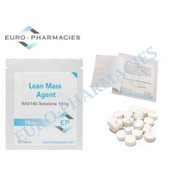Unlike anabolic steroids SARMs are designed to selectively bind to the AR (Androgen Receptor) while not binding to other places in the body that can commonly cause certain side effects as we see with anabolic steroids.
Rad 140 provides significant lean muscle gains without water retention since it does not aromatize into estrogen. This makes it suitable for lean mass gains in a bulking phase, or for preserving muscle in a cutting phase.
Common dosages are anywhere from 10mg-40mg, with 10mg being considered a great starting dosage to assess tolerance as everyone’s tolerance is different. Typical cycle length among users varies greatly but it seems the general consensus is 8-12 weeks.
Rad 140 users blood work has shown that it is suppressive to the HPTA (Hypothalamus-Pituitary-Testicular axis), which means it shuts down your bodies natural testosterone production. For that reason, I would suggest a PCT (Post Cycle Therapy) if you`re not a person that is on TRT. There is a lot of controversy around rather or not you need to run a test base with Rad 140, but there are users that report having great success running it without a test base along with other SARMs or as a solo compound. The general consensus seems to be that users have a better feeling of well-being when injectable testosterone is utilized along with Rad 140.
Rad 140 has not been shown to be liver toxic and it has been compared to taking Anavar in terms of the stress on the body (or the lack there of). While it does not convert to estrogen, user feedback suggests that if one utilizes it without a test base there is the potential that your ratio of testosterone to estrogen could become unfavorable which could be avoided with a testosterone base and proper AI (Aromatase Inhibitor) usage.
Lets look at some of the interesting things about this SARM. For starters, it has been shown to have neuroprotective properties, sources say it could possibly even aid individuals who are showing early signs of Alzheimer’s. The method in which this occurs is believed to be by protecting your brain from amyloid beta proteins and also by increasing brain cell growth.
Selective androgen receptor modulator RAD140 is neuroprotective in cultured neurons and kainate-lesioned male rats.
“The decline in testosterone levels in men during normal aging increases risks of dysfunction and disease in androgen-responsive tissues, including brain. The use of testosterone therapy has the potential to increase the risks for developing prostate cancer and or accelerating its progression. To overcome this limitation, novel compounds termed “selective androgen receptor modulators” (SARMs) have been developed that lack significant androgen action in prostate but exert agonist effects in select androgen-responsive tissues. The efficacy of SARMs in brain is largely unknown. In this study, we investigate the SARM RAD140 in cultured rat neurons and male rat brain for its ability to provide neuroprotection, an important neural action of endogenous androgens that is relevant to neural health and resilience to neurodegenerative diseases. In cultured hippocampal neurons, RAD140 was as effective as testosterone in reducing cell death induced by apoptotic insults. Mechanistically, RAD140 neuroprotection was dependent upon MAPK signaling, as evidenced by elevation of ERK phosphorylation and inhibition of protection by the MAPK kinase inhibitor U0126. Importantly, RAD140 was also neuroprotective in vivo using the rat kainate lesion model. In experiments with gonadectomized, adult male rats, RAD140 was shown to exhibit peripheral tissue-specific androgen action that largely spared prostate, neural efficacy as demonstrated by activation of androgenic gene regulation effects, and neuroprotection of hippocampal neurons against cell death caused by systemic administration of the excitotoxin kainate. These novel findings demonstrate initial preclinical efficacy of a SARM in neuroprotective actions relevant to Alzheimer’s disease and related neurodegenerative diseases”
Rad 140 is being studied for the treatment of prostate cancer. This SARM demonstrates the ability to bind to the receptors in the prostate to inhibit hyperplasia (enlargement of the prostate), as well as potentiality treating prostate cancer. This SARM could potentially be useful during usage of DHT (Dihydrotestosterone) steroids to prevent these drugs from binding to the prostate and causing prostate enlargement (hyperplasia). I personally have experience with prostate enlargement as a result of using DHT derivatives so this is of particular interest to me.
Selective androgen receptor modulators activate the canonical prostate cancer androgen receptor program and repress cancer growth.
“Prostate cancer (PC) is driven by androgen receptor (AR) activity, a master regulator of prostate development and homeostasis. Frontline therapies for metastatic PC deprive the AR of the activating ligands testosterone (T) and dihydrotestosterone (DHT) by limiting their biosynthesis or blocking AR binding. Notably, AR signaling is dichotomous, inducing growth at lower activity levels, while suppressing growth at higher levels. Recent clinical studies have exploited this effect by administration of supraphysiological concentrations of T, resulting in clinical responses and improvements in quality of life. However, the use of T as a therapeutic agent in oncology is limited by poor drug-like properties as well as rapid and variable metabolism. Here, we investigated the antitumor effects of selective AR modulators (SARMs), which are small-molecule nonsteroidal AR agonists developed to treat muscle wasting and cachexia. Several orally administered SARMs activated the AR program in PC models. AR cistromes regulated by steroidal androgens and SARMs were superimposable. Coregulatory proteins including HOXB13 and GRHL2 comprised AR complexes assembled by both androgens and SARMs. At bioavailable concentrations, SARMs repressed MYC oncoprotein expression and inhibited the growth of castration-sensitive and castration-resistant PC in vitro and in vivo. These results support further clinical investigation of SARMs for treating advanced PC”
It is very evident that EP produces some of the highest quality products on the market making the addition of this SARM to their product list that much more exciting.
-Matt88


